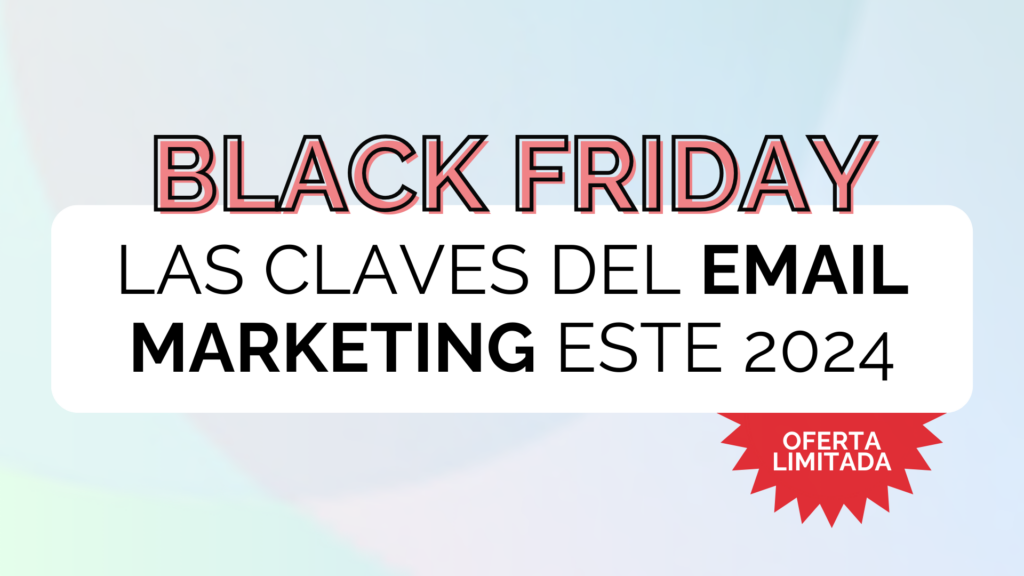Black Friday 2024: The keys to Email Marketing

As we all know, Black Friday is nowadays one of the most important and popular events in the world. most important trade events of the yearespecially for the retail sector. In 2024, email marketing campaigns play a key role in capturing the attention of consumers in the midst of competition and maximising sales opportunities.
Brands have adopted advanced strategies, from AI-driven personalisation to designing interactive and mobile-friendly experiences, all in order to stand out in a brand-saturated marketplace.
In this post, we will look at the key strategies that are making a difference in Black Friday campaigns, providing retailers with tools and approaches to optimise their results this shopping season.
1. AI-based personalisation
In 2024, artificial intelligence has improved personalisation in email marketing. Today, AI tools make it possible to process large volumes of data in real time, making it possible to personalisation that goes far beyond name or purchase history.
As a result, some retail brands are using technologies such as the machine learning and predictive models to personalise product recommendations within emails. This is based on data such as email open frequency, most visited product page and time spent on the website.
For example, an AI tool can analyse user behaviour patterns to recommend specific products that are more likely to convert. It can also personalise content in real time, such as displaying different discounts according to customer segmentation (new vs. returning) or applying real-time A/B testing to optimise messaging and calls to action.
2. Intelligent Automation to respond to peak demand
For Black Friday, retail brands are often confronted with unusual traffic peaks and demand. It is precisely for this reason that intelligent campaign automation has become essential to manage these peaks efficiently and without overloading the communication infrastructure.
Thus, platforms such as Salesforce Marketing Cloud, Klaviyo or Emarsys allow the creation of advanced automation flowsprogrammed to trigger emails based on real-time events, such as abandoned carts, specific site searches or even key product views.
Some brands have integrated AI to calculate the "best time to ship", also known as STO (Send Time Optimization), adjusting the sending time of each email depending on the user's previous activity to maximise openings and clicks. In addition, automatic multi-channel retargeting flows can be configured, combining email with SMS or push notifications to remind users of exclusive offers.
3. Temporary offers and emergency messages
The use of the scarcity principle is a proven Black Friday strategy. Many brands are starting to put countdowns and limited stock notifications in their emails. In this way, these strategies create a sense of urgency and motivate the customer to perform a certain action quickly.
It is therefore recommended to implement limited time or reduced stock offers in emails, highlighting these messages with eye-catching visual elements such as real-time timers.
4. Mobile-First and interactive visual content
With the rise in the use of mobile devices, the design mobile-first it is essential. In addition, 2024 will see a greater trend towards emails with interactive content, such as GIFs, videos or even carousels that allow multiple offers to be displayed in the same email. This type of content not only improves aesthetics, but also increases click-through rates and interaction.
A mobile-first design does not only imply a mobile-first format. responsivebut also a simple structure that facilitates reading and access to calls to action. The integration of interactive visual elements, such as GIFs, embedded videos, or image carousels, enhances the user experience and increases click-through rates.
5. Sustainability and responsible consumption
More and more consumers are looking to support brands committed to sustainability, and email marketing has evolved to communicate these values. As such, this year, we believe the message of responsible consumption will be present in many Black Friday campaigns.
Some brands are using email to highlight their environmental responsibility by creating sections dedicated to sustainable products or eco-friendly packaging. In addition, carbon footprint impact analysis tools can be integrated into email sends, which is an innovative way to show users the reduced impact of their purchases.
Thus, messages such as "With your purchase you support sustainable practices" or "Contribute to sustainability this Black Friday" resonate with sensitised customers, generating an emotional connection with the brand.
6. Value propositions for premium and loyal customers
Brands are also focused on rewarding loyal customers. This year's Black Friday campaigns could include exclusive benefits such as deeper discounts and additional gifts for those who are part of loyalty programmes or are premium customers.
As we have already mentioned on previous occasions, brands can automatically segment customers according to their level of loyalty and configure different email flows according to the profile of each user. Through CRM platforms, it is possible to grant advantages such as early access to the best offers, additional discounts or exclusive content, making the customer feel valued.
Loyalty programmes integrated into email are also effective; some examples include personalised links with special discount codes and access to products before the general public.
7. Post-Black Friday: Retention Strategies
Finally, many brands are using email marketing to maintaining customer interest after Black Fridaywith follow-up emails that include personalised thank yous, product recommendations and special offers for the holiday season. This allows you to extend the customer relationship beyond the impulse purchase and build a loyal customer base.
Brands are starting to use automatic post-purchase greeting series to fostering a long-term connection. These flows include emails thanking them for the purchase, requesting a product review and suggesting additional recommendations based on the recent purchase.
It is crucial to track the interests shown during Black Friday and tailor content to guide the customer towards future purchases, such as promotions for the holiday season.